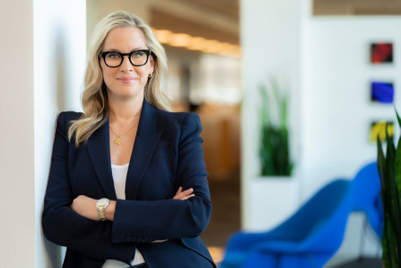
Brand awareness hasn’t been a problem for Zoom since COVID-19 hit.
Mentions of the video chat app have been seemingly ubiquitous since the pandemic forced work-from-home and quarantine measures on the public, in stories about the company itself to moments that happened on the platform, such as weddings or TV shows.
“I probably don’t need to spend as much time making sure people understand what Zoom is,” says the company’s global CMO, Janine Pelosi. “It’s officially a verb at this point.”
In December, Zoom had 10 million daily meeting participants. Four months later, that number soared to 300 million, as consumers in lockdown found themselves relying on the product for work, education, fitness, happy hours and just connecting with family and friends.
Zoom is “threading together everyone’s day,” says Pelosi, a huge shift from its pre-pandemic business model that was more focused on businesses. Before the onset of the virus, Zoom was concentrating on enterprise communications and helping large companies using its services for video, phone or conferencing needs.
“Now with all these consumer use cases, we need to make sure we are creating how-to videos for things that would have been taken care of by an organization’s IT department in the past,” says Pelosi. “But we are direct-to-consumer in this fashion.”
Zoom’s marketing team has been writing blog posts to help people understand how to use the tool and working with the company’s product teams to make sure the right default settings are in place for all new use cases. The how-to blog posts include how to securely host a virtual board meeting and best practices for securing a virtual classroom.
“I am focused on helping to manage that shift to ensure our product is as easy to use as it ever was for all these new use cases,” Pelosi says. “We want people to know how to use the product and make sure they understand the security features.”
Zoom has been under the microscope for security and privacy issues in recent months, due to built-in attention-tracking features and an uptick in “Zoombombings.” At least three lawsuits have been filed against the company over security and privacy issues.
“With these new use cases, many of our security features just weren’t on by default in some of our offerings,” says Pelosi. “That’s where listening to our customers, having a sense of urgency and adjusting quickly. That is what you really see from us.”
“We know the immense responsibility we have,” she says.
The pandemic has also forced Zoom’s marketing team to pick up the pace. Before, its initiatives would have been measured in quarters, months or weeks. Now everything Pelosi works on is gauged in hours or days.
She says that Zoom is a transparent company “inside and out,” which allows consumers to see how the company operates. “Going through a challenging time or crisis, sticking to those core values is imperative,” says Pelosi
Of course, Zoom isn’t all business for many users. It’s also gotten mentions in stories about celebrities using the app in fun ways. Pelosi says she particularly admires the way actor John Krasinski has integrated Zoom into his popular YouTube series, Some Good News, which made headlines this month when it featured the cast of The Office reuniting for a Zoom wedding.
“We helped them through our product, which has brought so much joy to folks and [Krasinski] created a platform that allows for so much joy to so many people,” says Pelosi.
The company is also partnering with brands on virtual events, such as Oprah Winfrey and WW’s Your Life in Focus: A Vision Forward – Live Virtual Experience.
It also worked with Dove to lift the 40-minute limit on free Zoom accounts, providing unlimited video calls to users over Mother’s Day weekend.
“One of the silver linings of any challenging time in human history is the innovation that comes out of it,” said Pelosi. “I am excited to see how things like the adoption of video or other tools that allow you to be productive in a remote workplace progress.”



.jpg&h=334&w=500&q=100&v=20250320&c=1)


.png&h=334&w=500&q=100&v=20250320&c=1)





.png&h=334&w=500&q=100&v=20250320&c=1)
.jpg&h=268&w=401&q=100&v=20250320&c=1)

.png&h=268&w=401&q=100&v=20250320&c=1)

.png&h=268&w=401&q=100&v=20250320&c=1)


